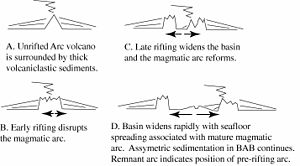
Back حوض القوس الخلفي Arabic Zaoblouková pánev Czech Backarc-Becken German حوضه پشتکمانی Persian Bassin arrière-arc French Cekungan busur belakang ID Bacino di retroarco Italian 背弧海盆 Japanese Bacia de retroarco Portuguese Zaoblúková panva Slovak

A back-arc basin is a type of geologic basin, found at some convergent plate boundaries. Presently all back-arc basins are submarine features associated with island arcs and subduction zones, with many found in the western Pacific Ocean. Most of them result from tensional forces, caused by a process known as oceanic trench rollback, where a subduction zone moves towards the subducting plate.[1] Back-arc basins were initially an unexpected phenomenon in plate tectonics, as convergent boundaries were expected to universally be zones of compression. However, in 1970, Dan Karig published a model of back-arc basins consistent with plate tectonics.[2]

© MMXXIII Rich X Search. We shall prevail. All rights reserved. Rich X Search